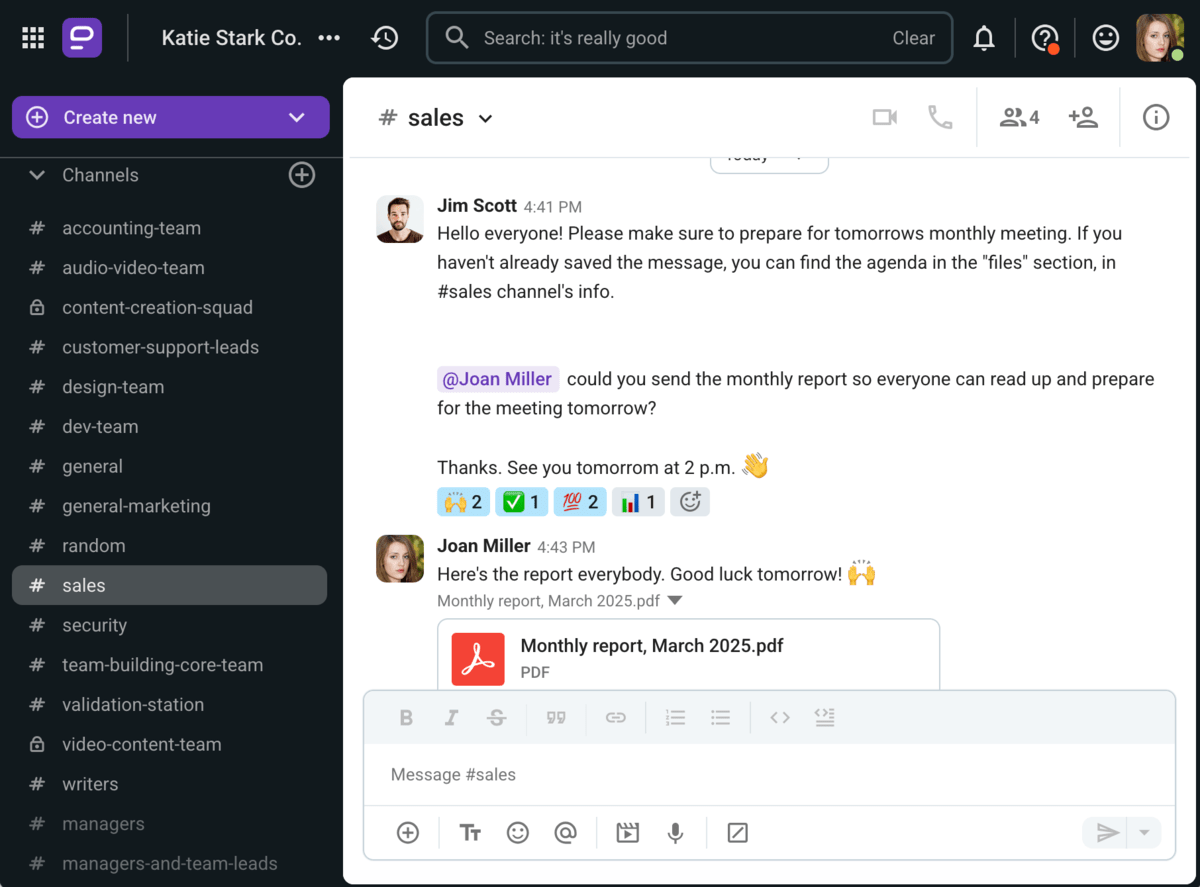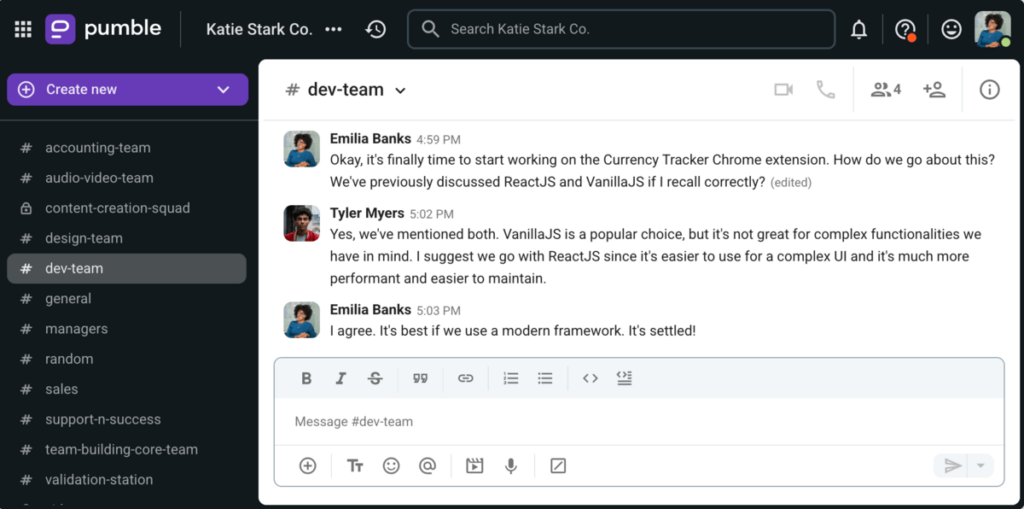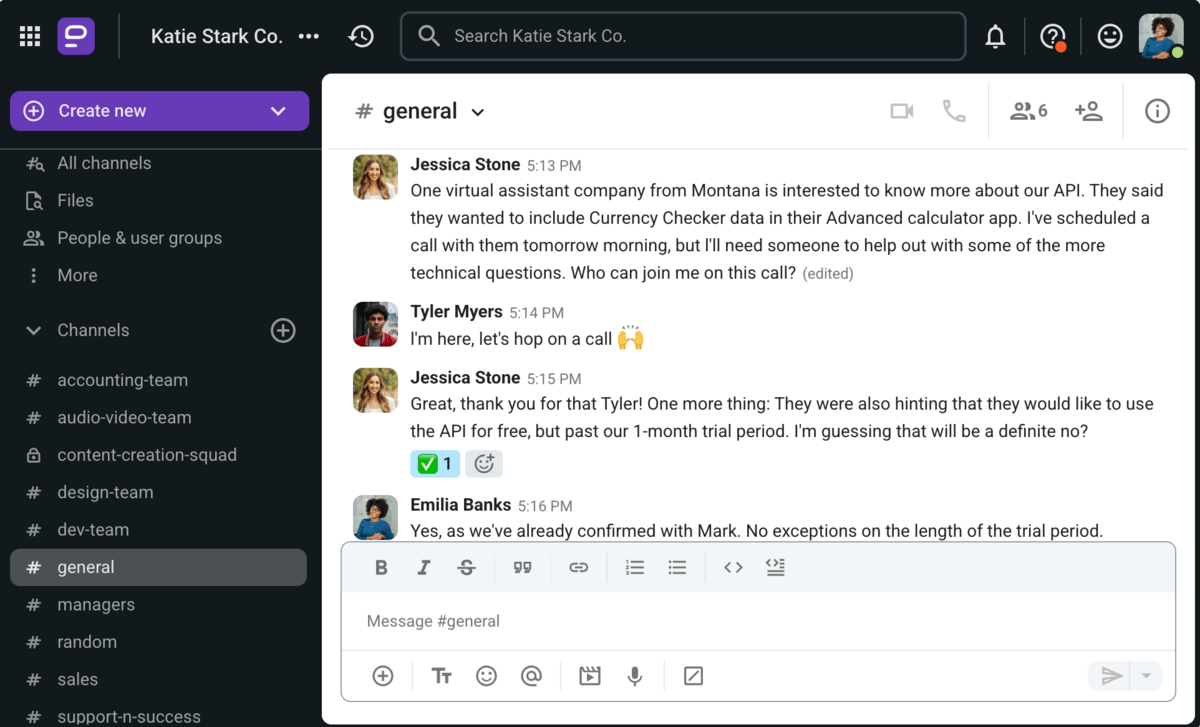Business communication is the basis for the success of any organization, regardless of its size, industry, or business model.
By addressing relevant problems and improving communication within your team, you can almost universally expect greater results in terms of performance, company image, team morale, and profit.
In this guide, we will cover every aspect of business communication, including:
- Business communication basics, definition, and examples,
- The importance of business communication and the problems it solves,
- The types and methods of business communication, and
- Tips and techniques on how to improve communication in business.
Let’s dive in and help you transform business communication within your team.

Business communication definition and key elements
Business communication is the exchange of information between two or more people inside and outside an organization.
Authors of Business Communication: Systems and Applications, Ricks and Gow, define business communication as “a system that affects the change within the total organization.”
The key 5 elements of business communication include:
- The sender — or the source, is the person or a group initiating the communication (employee, manager, customers, agencies, suppliers, contractors, etc.).
- Business information — the piece of information the sender wants to communicate to others (message, memo, email, document, report, etc.).
- Channel — the medium the sender uses to transmit the information (phone, email, letter, chat message, etc.).
- The Receiver — or the audience, represents the recipient of the business information.
- Feedback — or the response, refers to the reply conveyed by the receiver of the message. Feedback is an integral part of the business communication process, as it determines whether the business information (the message) is successfully sent and interpreted.
What makes business communication effective?
Effective business communication refers to any type of exchange of information inside and outside an organization oriented toward achieving business goals.
The purpose of business communication is to:
- Improve internal processes,
- Meet organizational goals, and
- Minimize mistakes.
Effective business communication binds all processes, workflows, and people within an organization into a coherent and productive unit.
In addition to affecting larger organizational processes, effective business communication is also integral to:
- Crafting proposals and plans,
- Reaching agreements,
- Conducting effective meetings, and
- Improving sales.
What are the types of business communication?
There are 4 main types of business communication in a typical organization:
- Internal upward communication — when a lower-level employee initiates a conversation with their superior.
- Internal downward communication — when a person at a higher hierarchical level initiates a conversation with a lower level employee (directive, instructional, and usually more immediate communication).
- Internal lateral communication — interaction between individuals or groups belonging to the same hierarchical level in an organization.
- External communication — communication with third parties outside the organization, such as the general public, clients, suppliers, partners, vendors, consultants, etc.
Knowing these 4 categories can help you analyze the areas in which your workplace communication needs improvement.
How do you improve communication in business?
As various communication surveys and studies confirm, improving your business communication brings immense rewards to your internal and external operations.
According to Pumble’s Workplace Communication Statistics, the cost of ineffective communication in the workplace amounts to anywhere between $10,000 and $55,000 per employee per year.
So, how do you create a good communication strategy in your organization?
Let’s break down some of the most effective tips on how to improve communication in business.
Tip #1: Assess the current state of your business communication and set goals
Analyzing the current state of your business communication will help you identify any weak links and blocks to improve upon. It will also serve as a great basis for setting the right goals for your future business communication.
To improve communication, the first step is to understand it. If you notice room for improvement in your workplace regarding communication, you will need to ask questions such as:
- At what stage in the communication process does miscommunication occur?
- Is this an internal, external, lateral, upward, or downward communication problem?
- In what way does poor communication hinder your business goals?
- Are there possible steps or procedures that can be implemented to avoid this?
- What is the simplest way to address communication problems in your team?
- Are there any major changes that need to be made for your team to function properly?
Once you identify the issues, you can start crafting a plan that addresses those exact pain points. In this case, the goal may include setting clear guidelines on the volume and quality of internal communication in addition to actionable points on how to put these into practice.
Tip #2: Identify key groups and analyze how they communicate with each other
Once you’ve analyzed the potential issues hindering your business communication as a whole, it’s time to make a more in-depth assessment of how core groups in your organization communicate.
This step can help you identify more specific issues and, thus, set more relevant goals and action plans.
To get started, try to first define the key groups whose operations rely on efficient communication and information sharing. You can categorize these into different levels, including:
- Horizontal groups — teams, units, or departments (e.g. marketing, design, sales, finance, human resources, etc.),
- Vertical groups — executives, managers, team leaders, team members, and
- External groups — clients, partners, vendors, consultants, etc.
Once you identify key groups, analyze their interaction using relevant parameters such as:
- Feedback,
- Reporting,
- Frequency of communication,
- Crisis communication,
- Irrelevant conversations,
- Meetings, etc.
For horizontal groups, you can assess which people, teams, and groups rely on regular communication to support daily, weekly, or monthly operations.
When it comes to vertical communication, consider analyzing the quality and frequency of feedback, reporting, progress tracking, and approval.
Similarly, external communication can be analyzed by frequency and quality of customer and partner communication.
The insight gained through this analysis can help you determine the optimum volume of communication needed to better support different processes and teams. Moreover, it can help you make more informed decisions when it comes to choosing the right communication channels and tools.
Tip #3: Define relevant methods of communication
Communication can be achieved by using various different methods. However, not all of them are necessarily relevant to every business.
Common business communication methods include:
- In-person meetings,
- Video conferencing,
- Phone and audio conferencing,
- Web-based communication,
- Written communication over shared files,
- Internal and external surveys,
- Customer management.
The choice largely depends on the type and the size of the business, along with the specific business communication goals you’re aiming to achieve.
For example, if your goal is to improve your cross-department communication and collaboration, you could set a web-based method as a default one for quick exchange of information, files, and feedback between teams.
At the same time, the communication methods also largely depend on the size and the business model in which organizations are operating. In line with this, a small in-office team would opt for in-person internal meetings, and they would use web-based messaging for collaboration and external communication.
However, a large, fully remote organization would have to rely on video conferencing as an alternative to face-to-face meetings, in addition to the web-based asynchronous collaboration.
Organize your meetings with Pumble
Tip #4: Apply the right tools
There’s no one-size-fits-all solution when it comes to choosing the right tools to facilitate business communication. It takes defining your unique needs and measuring them against the available tools to find the solution that perfectly aligns with your business communication strategy and objectives.
That being said, there are still several generally applicable functionalities to look for in a communication tool regardless of your business size, work model, or unique preferences. For example, features that are universally relevant are:
- A user-friendly interface,
- Maximum security, and
- Features enabling productive collaboration.
Here are some rules to follow when choosing and adopting the right business communication tools:
- Use a centralized platform for emails and calendars to automatically sync availability and better manage communication and collaboration across your organization.
- Store vital information and documents in the cloud with automatic backup to prevent losing critical data.
- Define some ground rules to have a consistent brand voice, tone, and chat etiquette across all communication channels. This will prevent potential misunderstandings and conflict from taking place, and ensure all teams are applying the principles of respectful communication in the workplace.
- Use a single business messaging tool company-wide. It’s very easy to fall into the miscommunication trap when one department uses one app while others are communicating over another.
- Look for multi-functional tools that facilitate streamlined collaboration. Features like file sharing, versatile messaging options, member availability, smart notifications, and seamless navigation provide a more efficient communication and collaboration experience.

Share files easily over Pumble
Tip #5: Identify and cultivate relevant business communication skills
Companies that invest their time and resources in improving communication skills in their workforce are likely to experience up to 25% higher productivity, according to Pumble Workplace Communication Statistics.
Understandably, higher employee performance and productivity lead to better overall business success.
Relevant business communication skills to look into are:
- Collaboration skills — Creating space for the development of collaboration skills allows teams to work together more effectively and discover more efficient ways to reach organizational goals.
- Diplomacy — Well-developed diplomatic skills allow sales representatives and customer support professionals to better understand customer perspectives and needs and thus provide better solutions and support.
- Negotiation skills — Integral to several other business activities, such as discussing salaries or promotions or communicating with investors.
- Presentation skills — Affects plenty of business activities and processes, starting from effective collaboration to acquiring clients and making sales.
- Public speaking — From delivering presentations and speaking at industry conferences to addressing investors or communities, most professionals are required to engage in some form of public speaking to captivate the audience’s attention and create a connection through storytelling.
- Active listening — Supports better work relationships and fosters more productive collaboration, in addition to being one of the key components of negotiation.
- Business writing skills — Mastering this business skill can help you in preventing misunderstandings, improving collaboration, ensuring clear task communication, and facilitating better work relationships.
- Conflict resolution — These skills help a team get out of a crisis and resolve conflicts and other stressful situations. It’s useful for managers and leaders, as well as lower-level employees, to manage stressful situations and find creative solutions for the issues at hand.
- Decision making — Key to successful goal-reaching, both in terms of individual and organizational objectives.
- Nonverbal communication skills — Professionals who master the skill of nonverbal communication have more success in getting the right message across in conversations with clients, team meetings, or industry conferences.
- Feedback and input communication skills — These skills offer substantial benefits in organizational performance and commitment and they are also valuable to employees on a more individual level as they support faster career advancement.
- Delegation skills — Help leaders effectively organize the workload and strategically assign tasks for maximum productivity.
Tip #6: Document and share your business communication processes
While working to institute more effective business communication practices, organizations need to ensure everyone is getting access to strategies, procedures, resources, tools, and learning materials.
Consider documenting your business communication processes and materials into one shared knowledge hub or a digital HQ to serve as a checklist for new and existing employees to reference.
Finally, share the document in a company-wide email or pin it in a #general channel in your company team messaging app to make sure it stays accessible and on top of everyone’s mind with the entire organization.

What methods of business communication does your team need?
When tasked with choosing the right communication methods for their team, organizations need to consider their unique needs and circumstances. There’s no single solution that works for all business models and sizes.
That being said, there’s still at least one universally applicable communication method the vast majority of organizations will find great use in — web-based communication.
Web-based communication can be used across various business models and sizes both for internal and external communication, while other methods largely depend on the unique needs and models specific businesses operate in.
Consider outlining your specific communication needs and preferences, as well as priorities and objectives, and measure them against the communication methods explained below to make sure you are making a well-informed decision.
Let’s take a deeper look at the different approaches and techniques that facilitate business communication that empowers entrepreneurs and motivates teams.
What are the most successful business communication methods?
In a larger sense, business communication can be categorized into two main methods — verbal and written.
In addition, depending on the business model an organization is currently operating in, we can further categorize both main methods into:
- In-person verbal communication and
- Remote verbal communication or written communication.
When it comes to the effectiveness of each method of business communication, there are no universally applicable rules. It is largely determined by the specifics of each organization and the model in which it operates.
We’ve already mentioned various methods of business communication. Let’s go in-depth and explore each one, so you determine the specific communication method your team needs to rely on and improve.
In-person meetings
Historically, in-person meetings have been the most common form of business communication.
According to the Virtual Versus Face-to-Face Meetings Study, the surveyed business managers have reported that close relations with partners and stakeholders can’t be established and developed without the help of face-to-face communication, which is why many still consider in-person meetings as a more favorable option for important external meetings.
Moreover, a recent MIT study reveals that in-person communication is drastically more engaging for our brains than online communication.
Video conferencing
As the closest equivalent to in-person meetings, video conferencing is another commonly used method of business communication.
From remote-first to fully in-office organizations, every business carries out the majority of their business meetings over video conferencing systems.
While on-site teams would resort to video for client and other third-party meetings, remote teams use video by default to facilitate more transparent and efficient communication and to strengthen team connection.

Create video conferences with Pumble
Phone and audio conferencing
Telephone and audio facilitate more productive meetings in remote and fast-paced business environments. Despite the lessened non-verbal content when compared to video, audio meetings still provide more accuracy than written business communication.
During a phone conversation, for example, participants are given more opportunities to decipher the tone of voice of other participants and thus reach a better understanding and faster agreement than over traditional, written communication.
Make important voice calls with Pumble
Web-based communication
Online channels such as email and team collaboration tools like Pumble have enabled faster business communication and collaboration.
This is especially beneficial for remote teams and teams operating across time zones that rely on asynchronous communication and collaboration to meet their business objectives.
Email and instant messaging enable distributed teams to share information more effectively over private, one-on-one conversations or with entire organizations or groups simultaneously.

Simplify team collaboration with Pumble
Written communication over shared files
Presentations, official documents, and reports present an important method of (written) business communication applicable to virtually any business.
Written business communication methods allow organizations to:
- Document processes,
- Collaborate more tightly,
- Share ideas, and
- Have more transparent and clear communication.
As mentioned above, remote teams and teams working across time zones in particular benefit from keeping vital business information in writing.
Internal and external surveys
Although commonly associated with external, customer feedback, surveys are also an important asset in internal communication.
Employee surveys are generally carried out in the form of anonymous online questionnaires.
Internal surveys are most commonly used to gather employee feedback on company policies and processes, but they also provide beneficial methods of assessing employee engagement, morale, and achievements.
Conversely, external surveys serve to evaluate customer needs, satisfaction, engagement or to perform market research. As SurveyMonkey finds, analyzing customer feedback improves a company’s chance of being successful by 33%.
Customer management
Communication related to customer management activities is another important method of business communication largely applicable in a modern business environment.
From live chat support and customer reviews to customer relationship management systems (CRMs), there are plenty of ways businesses are communicating with customers to enhance their experience.
It’s safe to say that customer satisfaction is directly related to the effectiveness and the quality of your customer management communication.
Examples of effective business communication
To better illustrate everything we covered so far, we prepared a couple of business communication examples.
These examples illustrate how business communication can be improved by relying on web-based communication tools to simplify the team communication process.
Example #1: Effective business communication improves processes
Effective business communication can improve processes in numerous ways. Communicating directly and respectfully is one of the best ways to achieve this, as it saves time, effort, and resources.
Let’s take a look at an example of effective business communication that improves processes.
Emilia, a team leader in the development department, starts a discussion about the technology the team will use for the upcoming project.
Tyler, a team member, provides the pros and cons of the two suggested types of tech and concludes his message by suggesting a final choice based on factual evidence and research.
Emilia responds by agreeing with Tyler’s choice. By making space for open communication and giving team members freedom to share their input and expertise, the team made the right choice.

Example #2: Effective business communication minimizes mistakes
By making it simple for team members to consult and plan, you can minimize mistakes in your team and avoid them before they even happen.
Take a look at this example.
Jessica, a sales specialist, receives a technical question from a customer, and she contacts the development team to give an accurate answer.
Tyler volunteers to jump on a call with the customer.
Jessica thanks her colleague after the call and follows up with another technical question to minimize potential mistakes and any false promises in the future.

Synchronize your team with Pumble
Improved business communication statistics
Let’s cover some of the most important benefits and proof of how improved business communication impacts different internal and external processes within a team.
#1 Effective business communication facilitates the preparation of plans and proposals
Managers with strong communication skills are more likely to engage a large team around a project and successfully implement vital tasks without any delays or losses.
Conversely, poor communication fails to communicate expectations and tasks clearly and, almost by default, reduces the chances of project success.
In fact, business leaders estimate their teams lose 7.47 hours per week due to poor communication, according to Grammarly’s research with the Harris Poll.
Strong business communication skills secure the success of projects or business proposals and plans.
#2 Effective business communication helps present and discuss ideas
Similarly to the previous point, effective business communication determines how new business ideas are communicated, perceived, and accepted.
Effective business communication:
- Enhances brainstorming,
- Facilitates constructive dialogue, and
- Supports transparency and understanding.
Specific communication techniques and skills largely determine how successfully people will get their ideas across.
#3 Effective business communication eradicates team silos
According to the Silo mentality in teams: emergence, repercussions and recommended options for change study, team silos result in collaboration problems, workflow inefficiency, and poor team organization.
With limited communication as one of the main causes for the origin of team silos, understandably, effective company-wide communication can prevent the issue from developing in the first place.
Transparent, assertive, and collaboration-based communication reduces the chances of developing the silo mentality and generates more opportunities for company-wide trust-building.
#4 Effective business communication facilitates better decision making and execution
Business communication is instrumental to decision making, and it also largely determines how the decisions will be applied.
Effective communication facilitates a constructive decision-making process by reducing the risk of information overload and excessive data.
Clear, concise, and structured information shared via effective business communication leaves more cognitive capacity for decision making rather than processing excessive information.
Moreover, effective business communication plays an important role in how the decisions will be perceived, and, ultimately, realized. According to organizational communication literature, effective strategic communication is considered vital in communicating “the contents of company strategy and important corporate decisions to key stakeholders, both internal and external.”
#5 Effective business communication improves talent retention
A 2024 research by USC Annenberg and Staffbase finds that 61% of employees who are unlikely to stay at their job cite poor communication as one of the primary reasons.
Unsurprisingly, employees are more likely to stay longer at organizations that cultivate effective internal and external communication practices. This is especially true for teams nurturing effective internal team communication built on trust and joint collaborative effort.
#6 Effective business communication increases productivity
Communicating to employees clearly about how their work impacts the larger goal can lead to 10% higher performance, Gartner reports. Moreover, Gartner also shares that more informed employees are more likely to outperform their less-informed peers by a staggering 77%.
By installing effective business communication plans — that prioritize streamlined communication and collaboration — organizations are more likely to experience immense productivity returns.
#7 Effective business communication facilitates more constructive meetings
As Pumble’s Meeting Statistics from 2024 suggest, employees spend approximately 31 hours in unproductive meetings each month.
Developing strong communication in your workplace is one way to lower these numbers for your team. Teams with members who are aware of their precise duties and deadlines are, by default, much more efficient and productive.
Depending on your team, there are many possible drivers of more effective business communication.
A recent 2023 Emerald Insight Study concluded that effective pre-meeting communication, such as sharing agendas and other materials in advance, helps meetings have more productive outcomes.
#8 Effective business communication improves sales
Effective communication is the key driver of sales success. As revealed by a study on the role of communication skills for sales force, clear task communication in teams and optimally developed presentation skills largely impact the success in reaching sales targets.
Communication still plays a major role in sales, even in a digital environment that dictates different interactions, as the study Salesperson communication effectiveness in a digital sales interaction reveals.
#9 Effective business communication builds trust
According to Sciendo’s 2024 study, communication and teamwork skills create a significant and positive impact on employee trust in the workplace.
Organizations lacking transparent and honest communication strategies are more likely to experience misunderstanding, mistrust, and overall low employee morale that harms company culture.
In addition, a study titled Building organizational trust through internal communication observed a statistically significant positive relationship between internal communication satisfaction and organizational trust.
Improve business communication with Pumble
Effective business communication is the backbone of organizational success, driving collaboration, productivity, and employee engagement.
Recognizing its pivotal role, organizations are turning to dynamic solutions like Pumble to revolutionize their communication.
Pumble is a team communication app that streamlines clear communication and fosters collaboration among team members. With a focus on enhancing exchanges, Pumble offers a suite of robust features designed to boost productivity and harmony in the workplace.
Empower your workforce with Pumble’s versatile toolkit, which includes:
- Customizable channels,
- Threaded conversations,
- Direct messages,
- File sharing,
- Screen sharing,
- Video calls, and more.
These features enable teams to work more efficiently towards shared goals.
With Pumble as your ally, your team can communicate more effectively, collaborate seamlessly, and elevate your business communication strategies to new heights.
Make Pumble your team communication app and enhance business communication for company-wide success.
How we reviewed this post: Our writers & editors monitor the posts and update them when new information becomes available, to keep them fresh and relevant.



